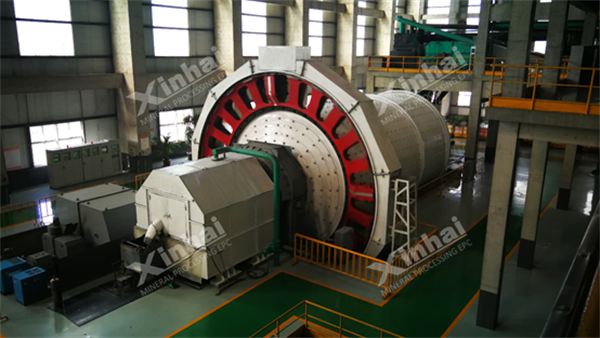In the gold ore dressing plant, the ball mill can be considered a major energy consumer. According to statistics, the energy consumption of crushing and grinding operations accounts for 65%-75% of the total energy consumption of the entire beneficiation plant. Therefore, in order to reduce production costs and increase economic benefits, optimizing the ball milling section will undoubtedly yield significant results. This article introduces a case study of energy saving and increasing economic benefits in the beneficiation plant through the precise filling of balls technology.

Choosing the appropriate grinding fineness can achieve the dissociation of useful minerals from gangue minerals. So, how to control the grinding fineness within a reasonable range? The precise filling of balls technology can improve the dissociation degree of target minerals and the grade of flotation concentrate, enhance the processing capacity of the ball mill, reduce grinding consumption, and ultimately achieve the goal of reducing beneficiation costs.
The ball milling section of the gold ore dressing plant adopts a closed-circuit grinding process, with a 3240-type ball mill. The mill processes newly fed ore with a relatively fine particle size, with only about 1% at the +14mm level and 5%-6% at the -0.074mm level. However, the product fineness discharged by the mill combined with the classifier is relatively coarse, with the -0.074mm particle level accounting for only about 45%.
After inspecting the operating parameters of the mill on-site, the following problems were identified:
(1) The size of steel balls is too large, with a mass ratio of φ100mm steel balls to φ60mm steel balls being 6:4.
(2) Insufficient ball filling. According to the plant regulations, the ball filling of the 3240 ball mill should be 45t, but the actual ball filling is only 42t.
(3) The processing capacity of the mill is only 50t per hour, which does not meet the design requirements.
(4) The sand return ratio of the classifier is too high, calculated from on-site sampling to be 3.12%, resulting in high electricity consumption and severe wear of overflow parts.
(5) The flotation process is unstable due to the coarse grinding products, leading to unstable subsequent flotation operations and foam layer, resulting in unsatisfactory beneficiation indicators.
The precise filling of balls involves screening and analyzing the incoming ore slurry to select the maximum particle size in each particle size group. Other mill parameters obtained from on-site inspections were used in the Sondheimer's ball diameter theory formula to calculate the initial ball size. Based on the ratio of yield in each particle size group of the screened ore slurry, the weight ratio of different-sized steel balls can be determined.
To address the problems encountered during on-site inspections, a precise filling of balls scheme was designed for the beneficiation plant's mill. A series of large-scale experiments on precise filling of balls were conducted before industrial trials. The final selected initial ball scheme was: φ60: φ50: φ40: φ30 = 20%: 30%: 40%: 10%.
Since the precise initial ball load naturally disappears after a period of operation due to wear, precise filling of balls operation must be carried out to maintain the accuracy of the overall ball load. Based on the on-site grinding parameters and drawing method, a supplementary ball scheme was ultimately determined as: φ80: φ60: φ40 = 1:1:1.
After adopting the new supplementary ball scheme, the mill's hourly production capacity increased by 2.6t/h, the grinding fineness increased by 11.9%, the electricity consumption and ball consumption in the new steel ball system decreased by 2.17 kW·h/t and 0.21 kg/t respectively, the recovery rate increased by 1.34%, and the concentrate grade increased by 2.05%.
It can be seen that by making gold ore ball mills more energy-efficient and increasing economic benefits, in addition to focusing on the performance of the ball mill itself and the compatibility with the classification equipment, attention should also be paid to whether the ball filling parameters are reasonable. Through precise calculation and adjustment of the initial and supplementary ball schemes, significant gains can be achieved unexpectedly.